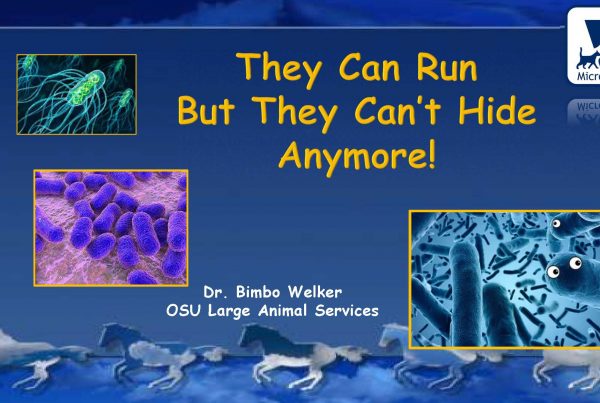By Dr. Lauretta Ihonor
Biofilm infections have long been a source of great interest and concern among veterinary physicians. Not only do they occur at a high frequency—causing up to 80 percent of infectious animal and human diseases, according to Abdullahi et al—they are also extremely hard to treat because enzymes in the biofilm’s polymeric matrix protect microorganisms against antibiotics and host defenses. And with hard-to-treat biofilm infections commonly manifesting as chronic and recurrent infections among equine, livestock and domestic pets, effective diagnosis and treatment of biofilm infections is of paramount importance to veterinary physicians worldwide.
Current Practices in Biofilm Infection Diagnosis
Both the microbial diagnosis of biofilm-related infections and identification of the antimicrobial agents they will respond to present a big challenge to veterinary clinicians today. As highlighted by Macià et al in the Spanish journal Enfermedades Infecciosas y Microbiología Clínica, it is a challenge that arises from an absence of two things: a diagnostic consensus on how best to treat biofilm infections and standardized protocols for their investigation.
While microbial culture is recognized as a failsafe diagnostic method for standard infections (as highlighted in Abdullahi et al’s literature review), the complex polymicrobial nature of biofilms and their adherence to certain surfaces makes this approach problematic when dealing with biofilm infections. Specifically, false negative cultures often arise from the hard-to-culture nature of biofilms, while false positive results can result from the presence of free-moving planktonic bacteria. With such limitations compromising the accuracy of microbial culture for biofilm infection diagnosis, it is clear that the most effective diagnostic approach to these types of infections must involve the precise identification of specific microbes.
DNA Testing for Biofilm Diagnosis
The development of polymerase chain reaction techniques in the 1970s improved the ease with which clinical detection of infections could be performed. By detecting microorganisms through the amplification of single or multiple copies of bacterial DNA, PCR became an ideal diagnostic tool for infections caused by difficult-to-culture pathogens or microorganisms with long cultivation times. However, researchers such as Hajia in Modern Medicine Laboratory Journal have highlighted shortcomings that include the inability to identify more than a dozen microorganisms in a single test and a tendency for artifact creation during the amplification process and amplification of contaminants. For these reasons, PCR remains of limited use when clinicians require an accurate picture of all the pathogens present in a biofilm.
In contrast, with high sensitivity and specificity when detecting microbes using host genetic material, next-generation sequencing is ideal for the microbial diagnosis of biofilm infection. Not only does it produce more specific and sensitive results than conventional cultures and PCR, NGS can also identify all the different microorganisms that underlie a biofilm infection and the ratio in which these organisms exist in the biofilm. It achieves this by comparing all the DNA found in a microbial sample against a vast and comprehensive database that contains more than 25,000 bacterium and fungus DNA profiles.
Internal Medicine specialist Dr. Bonnie Barr uses NGS when treating horses at Rood and Riddle Equine Hospital in Lexington, Kentucky. She says, “Next-generation DNA sequencing technology allows the clinician to survey the entire landscape of bacteria involved in an infection, which is important especially in the case of a chronic infection.”
She adds, “With this information, the clinician can determine the clinically relevant pathogen or pathogens. Identification of microorganisms at the molecular level provides a diagnostic method to overcome the shortcomings of traditional culture.”
Small Animal Dermatologist Dr. Michael Rossi, Director of Clinical Studies and Staff Dermatologist for Coastal Veterinary Dermatology & Ear Clinic in Houston, TX, agrees. “From a dermatology standpoint, we are increasingly seeing multiple antimicrobial resistant skin infections on a daily basis. We know that traditional culture methods fail to provide accurate results in many cases where there is biofilm involvement.“
With this in mind, Dr Rossi believes that it’s time for the veterinary world to follow in the footsteps of human microbial diagnostics—a field that has experienced a transformation in the management of difficult-to-treat human infections since the adoption of DNA sequencing as a diagnostic tool.
And when it is considered that DNA-based microbial analysis permits the identification of genes resistant to specific antibiotic classes, the importance of this diagnostic tool in veterinary medicine becomes all the more apparent, as it allows clinicians to immediately begin the most appropriate treatment.
Using NGS Diagnostics in Clinical Practice
While NGS presents clear diagnostic advantages, its use is currently not widespread among veterinary physicians. This may be due to one commonly cited concern which is the belief that NGS is a more expensive diagnostic tool than conventional culture. However, as Dr. Rossi (who uses NGS in his veterinary practice) highlights, this is incorrect. He points out that when animals have a chronic skin infection, their owners often end up paying hundreds or thousands of dollars for ongoing clinic visits, repeat tests and antibiotics that may prove ineffective.
“This not only costs money, but also may not fully treat the patient,” he says, adding that the cost of ongoing tests could be “negated by doing an advanced diagnostic test at the very beginning of the investigative process.” This would allow the most appropriate antimicrobial therapy for the infection to be quickly identified and started sooner rather than later, he concludes.
But not only is the cost of NGS-based diagnostics mitigated by the cost savings of receiving an accurate early diagnosis, obtaining such diagnostics from companies like MicroGen Vet can help to drive this cost down further. As an exclusive reseller of NGS services from human NGS diagnostics leader MicroGen DX, MicroGen Vet capitalizes on the volume of work that already passes through MicroGen DX’s lab, allowing the company to offer the diagnostic service to veterinary physicians at a price that is very competitive to commonly used culturing or PCR diagnostic services.
The Future of Biofilm Infection Diagnosis
As Abdullahi et al state in a paper published in Veterinary World journal, the continued growth of biofilm infections and their resistance to common antibiotics in veterinary medicine suggest that biofilm infection is a clinical problem that will present significant animal health challenges in the future. When the impact of such infections on livestock and farming is considered, it seems inevitable that greater economic losses will follow unless something is done to remedy the situation. It is, therefore, all the more important for quick and accurate diagnosis and treatment of biofilm infections to become commonplace. NGS presents the ideal method for achieving this goal—a goal that will benefit animal owners at a personal level, as well as the wider community at a national and global economic level. The experiences reported by existing veterinary users of NGS-based diagnostics are already overwhelmingly positive, with many recognizing the clear value the tool brings to veterinary practices.
“As clinicians become more comfortable with the test and interpretation of the results, they will realize the true value,” says Dr. Barr. And as a method with a low learning curve, the discovery of that true value is likely to come quickly to most veterinarians.
Lauretta Ihonor is a medical doctor and a freelance health journalist/writer who also holds a BSc in genetics. She is based in London, UK and specializes in writing about medical technology, genetics and general medicine. She has worked for CNN International, BBC and Sky News.
References
Abdullah UF, Igwenagu E, Mu’azu A, et al. Intrigues of biofilm: A perspective in veterinary medicine. Vet World. 2016 Jan; 9(1): 12-18.
Macià MD, Del Pozo JL, Díez-Aguilar M et al. Microbiological diagnosis of biofilm-related infections. Enferm Infecc Microbiol Clin. 2018 Jun – Jul; 36(6):375-381.
Masoud Hajia. Limitations of Different PCR Protocols Used in Diagnostic Laboratories: A Short Review. Mod Med Lab. 2017; 1(1): 1-6






